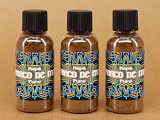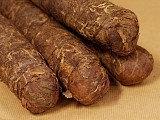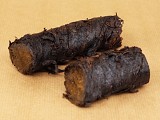100 Gr from Brazil (SKU 5087)
Restock expected. Brazilian Moi Tabaco comes in rolls similar to Peruvian Mapacho "masos". The leaves are harvested and dried, then wrapped into 100 cm long bundles and left to mature. Then the rolls are compressed by wrapping a rope around it tightly and left to cure again. Produced according to an old traditional method, this Rustica variety is locally used for ceremonial pipes and for blowing healing during curing ceremonial rites, and to produce mild to strong Rapé. The rolls are fresh and juicy. They were cut into small sections and vacuum-sealed when we received them, to keep them fresh and preserved during storage and transport. Detailed information can be found below.
The rolls weigh approximately 100 gram and are 4 to 7 cm in diameter.
| change currency | |||||||
| SKU | Weight | Unit | Price | Qty
|
|||
|---|---|---|---|---|---|---|---|
| 5087 | 100 gr | 1 pc | $ 17.63 | ||||
| 5088 | 250 gr | 1 pc | $ 40.31 | ||||
| 5089 | 500 gr | 1 pc | $ 75.57 | ||||
To read an extensive article about Tabaco de Moi, click here.
Tabaco de Moi: A Journey into Brazilian Tabaco Craftsmanship
Tabaco de Moi, also commonly referred to as Fumo de Rolo, is a unique variety of Nicotiana Rustica known for its sweet, mild flavor and deep cultural roots in the Amazon region of Brazil. This Tabaco is highly prized for its exquisite aroma, solid, nearly black appearance, and robust quality. Grown in the upper Jurua region of Acre, Brazil, Tabaco de Moi represents a tradition of meticulous craftsmanship passed down through generations of Tabaco farmers and indigenous communities.
Historical Background and Cultural Significance
The history of Tabaco de Moi is closely linked to the early 20th-century rubber boom in the Amazon. During this period, Northeastern Brazilians, known as "soldados da borracha" (rubber soldiers), migrated to Acre in search of economic opportunities. These migrants brought with them Tabaco seeds from the Northeast, a region with a long history of Tabaco cultivation. These seeds were likely crossbred with native strains from the Amazon, resulting in the unique variety now known as Tabaco de Moi.
The name "Moi" is thought to have originated from the Portuguese word "moles," which referred to the intertwined bundles of Tabaco leaves designed to withstand long sea voyages. Over time, Brazilian settlers adapted the term to "Moi." The broader term "Fumo de Rolo" is commonly used across Brazil to describe this traditional method of rolling Tabaco leaves into dense, cylindrical bundles or "ropes."
Cultivation and Production Process
Tabaco de Moi is cultivated organically in the rich soils of the Amazon rainforest, free from chemical fertilizers and pesticides. Tabaco plants are naturally resistant to pests and help enhance soil fertility, making them ideal for organic farming practices.
After harvesting, the Tabaco leaves are carefully sorted based on quality and placed on drying racks in the shade. This slow drying process is essential for preserving the leaves' natural oils and flavors. Unlike other Tabaco varieties, the central leaf grain is not removed during the drying process, which contributes to the Tabaco's dense and solid structure.
The leaves are then skillfully interlaced and twisted into ropes, forming the characteristic shape of Tabaco de Moi. These ropes are tightly wrapped with natural materials such as tree bark or plastic strings and left to ferment for several months. The fermentation process deepens the Tabaco's flavor and darkens its color, resulting in the rich, dark brown to almost black appearance that Moi Tabaco is known for.
Characteristics and Uses
Tabaco de Moi (Fumo de Rolo) is distinguished by its dense, solid structure and its dark, sticky leaves. The ropes of Tabaco are longer and more tightly packed than other similar varieties, such as Peruvian Mapacho, with a diameter of approximately 6-7 cm and a length of about 100 cm. The leaves, which have undergone extended fermentation, are dark, aromatic, and have a mild, sweet flavor.
This Tabaco is highly valued in the production of Rapé, a sacred snuff used by many indigenous tribes in the Amazon. The mild flavor and grounding effects of Moi Tabaco make it ideal for spiritual practices that require focus, clarity, and connection to the earth. Its sweet aftertaste and pleasant aroma contribute to a more refined and gentle Rapé experience, making it a favorite among those who seek a balanced and uplifting effect.
In addition to its use in Rapé, Tabaco de Moi can be smoked or chewed, offering a versatile experience for those who appreciate traditional Tabaco consumption methods. The Tabaco's mildness and aromatic qualities make it suitable for those who prefer a less intense experience compared to stronger varieties like Sabia or Arapiraca.
The Spirit of Tabaco de Moi
Tabaco de Moi, also known as Fumo de Rolo, represents more than just a product; it is a symbol of cultural heritage and craftsmanship in the Amazon. The traditional methods used to produce Moi Tabaco have been passed down through generations, preserving the knowledge and skills required to create this exceptional product. The organic farming practices, combined with the careful drying, twisting, and fermenting processes, ensure that each rope of Tabaco de Moi carries with it the essence of the Amazon rainforest.
Whether used in sacred rituals, for smoking, or in the creation of Rapé, Tabaco de Moi offers a unique and deeply satisfying experience. Its sweet, mild flavor, coupled with its rich cultural significance, makes it a standout among the many varieties of Tabaco grown in Brazil. For those who seek a connection to the traditions of the Amazon and a taste of its rich, aromatic Tabaco, Tabaco de Moi provides a journey into the heart of Brazilian craftsmanship and cultural heritage.
To read an extensive article about Tabaco de Moi, click here.
Image: Tabaco de Moi in sections
Scientific name: Nicotiana Rustica
Part used: Leaves
Form: In 100 cm long sticks / rolls
Region of origin: Alto Juruá, Acre state
Lot number: 202048
Method of processing: Leaves are rolled, wrapped and cured to form solid mass "moi" rolls.
Appearance: Moi rolls wrapped in plastic string.
Colour: Brown
Odour: Tabaco
Taste: Tabaco
Uses: Alcoholic tinctures, natural agriculture, apiculture
Customer feedback:
"...This Tabaco is wonderfull. In taste and looks it resembles the Peruvian Mapacho a lot although it has it’s own character. Experiencing it is quite different. In my experience it goes a bit deeper and the clearing of sticky energies is a bit more effective. Ideal for snorting, beautifull taste, sweet smell and full aroma. The spirit of Tabaco is very present in this one. Love it!..."
See here how to make powder from raw Tabaco.
See here how to blend your own Rapé.
Other names: Moi, Moi Tabaco, Nicotiana rustica logs
All South American shamans have an intimate relationship with Tabaco, and consider it a very sacred, wholesome plant that is deeply entrenched in their culture and rites. Tabaco consumed in high amounts has strong psychedelic and hallucinogenic effects, as it contains two alkaloids, harman and norharman, which are closely related to harmine and harmaline (Janiger et al. 1973). These two beta-carbolines inhibit monoamine oxidase (Herraiz et al. 2005), leading to antidepressive and uplifting effects (Farzin 2006).
In addition to Ayahuasca rituals that are combined with Tabaco snuffs, there are even shamans that specialized in Tabaco healing, called tobaqueros (Jauregui et al. 2011). When used in shamanic rituals, Tabaco is assumed to protect, cleanse and re-align energies, thereby bringing profound clarity and healing (Jauregui et al. 2011). Furthermore, South American shamans, commonly use Tabaco smoke to blow it over the person to be healed with the intention to bring their energies into equilibrium and clean out all negativity and anxiety (i.e. ‘sopladas’ – the healing energy of blowing) (Jauregui et al. 2011). Thus, Tabaco in the shamanistic culture has a potent function of cleansing, bringing clarity and focus, and for allowing strong visualizations.
Nicotiana Rustica is extremely potent, containing up to 20 times higher levels of nicotine than usual Tabaco, Nicotiana Tabacum (Stanfill et al. 2010). Therefore, this shamanic tool is extremely powerful and can provide an intense journey of cleansing and energetic shift. Through this highly activating Tabaco, one might feel a strong aiming of the mind, and intense clarity and focus.
The Brazilian "Tabaco de Moi" Maso is juicy and fresh when arrived in our stock. We remove the outer plastic wrapper, cut them into the desired sections and immediately vacuum seal them. This way they will retain their freshness and humidity content for a very long time.
The seeds of this special kind of Tabaco have been passed down from father to son over generations and it belongs to the widely known species of Nicotiana Rustica. Yet there is no commonly known name attached to it, but it could be compared to Mapacho, for it looks very similar. (The diameter is approximately 6-7 cm). The Moi is compressed and more dense and solid compared to Peruvian Mapacho. The "Tabaco de Moi“ maso is longer than the Mapacho masos (100 cm long) and also it is much more dense in its structure. The leaves appear to be a bit darker as they have been put through the process of fermentation. It has been organically grown in the jungles of Brazil. Chemicals are not necessary as Tabaco itself is a great fertiliser and commonly used insecticide among the farming communities.
Instructions for Proper Handling and Storage of Compressed Raw Tabaco
Compressed raw Tabaco, such as Mapacho or Arapiraca, is a fresh, humid product that requires careful handling to maintain its quality and prevent mold. These products are shipped from South America vacuum-sealed, and undergo strict quality checks upon arrival. They are individually checked, and again vacuum-sealed under maximum vacuum to ensure they remain fresh during storage and transport. Additionally, a light spray of bio-ethanol is applied to eliminate any traces of mold, which is part of the natural fermentation process. When you first open the package, you may notice the smell of alcohol, which will evaporate quickly.
To ensure your raw Tabaco remains in optimal condition, follow these detailed instructions:
Long-Term Storage in Vacuum-Sealed Packaging
Inspect the Packaging: Upon receiving your Tabaco, ensure that the vacuum seal is intact. The packaging should be tightly sealed around the Tabaco. If the package feels loose or you can move the Tabaco roll inside, the seal may have been compromised, possibly during customs inspection. In this case, it is recommended to follow the instructions for handling after opening immediately.
Storage: If the vacuum seal is intact and you do not plan to use the Tabaco immediately, store the package in the refrigerator or freezer. This cold environment will help preserve its moisture content and prevent deterioration, allowing the Tabaco to remain fresh for several months or longer.
Handling After Opening
Unpacking: When you open the vacuum-sealed package, remove the desired section of Tabaco and discard the plastic. To preserve the remaining material, store it open to the air in a dark, well-ventilated cupboard. Keeping the Tabaco exposed to air circulation will prevent excess moisture from accumulating, which can lead to mold formation. Ensure that the storage area is away from direct sunlight and not exposed to high humidity.
Monitoring and Maintenance
Regular Checks: Periodically check your Tabaco for any signs of mold or dryness. If the outer layer becomes dry or brittle, lightly mist it with distilled water. Allow the Tabaco to absorb the moisture gradually by leaving it in the open air. Avoid storing the Tabaco in plastic bags, as this will trap moisture and increase the risk of mold.
Alternative Storage in Humid Conditions
Humidity Management: In areas with high humidity, even storing Tabaco in paper can result in mold. In such environments, the best practice is to keep the Tabaco completely open to the air in a dark, dry place with good ventilation. This will help prevent moisture buildup. Ensure that the storage area is away from light and excessive humidity.
Freezing for Indefinite Storage
Freezer Storage: For long-term storage, consider cutting the Tabaco into smaller portions and storing them in individual grip-seal bags in the freezer. This method allows you to preserve the Tabaco indefinitely, defrosting only the amount you need at any given time. Freezing helps maintain the product’s integrity without the risk of mold.
Important Notes
Avoid High Humidity: In humid environments, keeping the Tabaco in paper can still lead to mold. The best practice is to keep it open to the air in a dark, well-ventilated space.
Regular Checks: Regularly inspect your Tabaco for any signs of mold or dryness. Adjust the storage method as necessary to ensure the product remains in optimal condition.
By following these guidelines, you can help ensure that your compressed raw Tabaco stays fresh, mold-free, and ready for use whenever you need it. Proper handling and storage are key to preserving the quality and longevity of this traditional and organic product.
This item is not allowed in the following countries:
Australia, United Kingdom
This natural product is offered for its ethnographic and historical value and is delivered with no expressed or implied fitness for a specific purpose. It is simply a raw botanical specimen, or a scientific sample. The information provided is purely meant for historical, scientific and educational purposes and should never be interpreted as a recommendation for a specific use. The use and application of our product is at the customer's decision, responsibility and risk.
Read our Terms & Conditions for more details.



